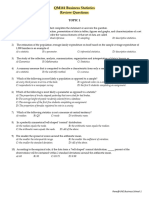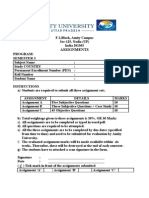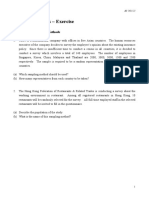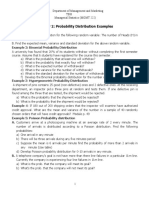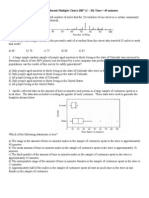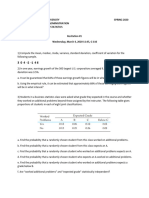Problem Set 1 - Introduction To Basic Data Anaysis and Graphical Methods
Uploaded by
knocarchi smithProblem Set 1 - Introduction To Basic Data Anaysis and Graphical Methods
Uploaded by
knocarchi smithUniversity of the West Indies
Department of Economics
ECON1005 - Introductory Statistics
Problem Set 1: Introduction to Basic Data Collection & Graphical Methods
Tutorial Questions
1. An online retail company would like to increase its sales revenue. To do this they go to a popular
shopping area and ask 250 persons “What is the number one reason you go back to an online site
to make a purchase?” (note respondents can only give one answer)
a) What is the population for this study?
b) What is the sample for this study?
c) What sampling method was used to select the respondents for this study?
d) Is this study using primary or secondary data?
e) What type of variable (nominal, ordinal, interval, ratio) is the variable being studied (i.e. reason to back
to a website to make a purchase)?
2. Match each of the following with the SINGLE choice that best describes the given situation. Each
answer choice may be used once, more than once, or not at all.
A. Simple random sample B. Stratified random sample C. Multistage random sample
D. Voluntary response E. Cluster sample
a) A company would like to determine the average commute to work for their employees. They obtain a
list of all 500 employees and sorted them according to their assigned department. They then select 3
departments and then interview 10 persons within those selected departments.
b) A company would like to determine the average commute to work for their employees. They obtain a
list of all 500 employees and sorted them according to classification (e.g. entry level, intermediate
level, middle management, senior management). They then interview 10 persons from each
classification.
1 ECON1005: INTRODUCTORY STATISTICS
PROBLEM SET 1
c) A company would like to determine the average commute to work for their employees. They obtain a
list of all 500 employees and select 80 from that list.
d) A company would like to determine the average commute to work for their employees. They obtain a
list of all 500 employees and sorted them according to their assigned department. They then select 3
departments and interview all persons within those selected departments.
e) A company would like to determine the average commute to work for their employees. They obtain a
list of all 500 employees. They decide to leave questionnaires in the lunch room with a sign asking
persons to participate.
3. Determine whether the following situations refer to a parameter or a statistic.
a) A company would like to determine the average commute to work for their employees. They obtain a
list of all 500 employees and select 80 from that list and obtain the average.
b) A lecturer would like to determine the average score for Midterm #1.
c) A production facility would like to determine whether the burn rate for the candles which they produce
is within the allowable limit. Note: to calculate the burn rate, the whole candle has to be destroyed.
They obtain an average burn rate of 0.01 mm/second.
4. Match each of the following with the SINGLE best choice that would be used in the given situation. Each
answer choice may be used once, more than once, or not at all.
A. Histogram B. Cumulative Ogive C. Bar Graph D. Pie Chart E. Stem & Leaf
a) An evaluator wants to determine how many the number of persons who own cars that are more than 10
years old (without having access to the raw data).
b) Distance in kilometres to school for 3000 students.
c) Membership in school organizations for 100 students. Note that students may belong to more than one
organization.
d) The age distribution of 50 students in ECON1005?
5. Figure 1 shows the cumulative results for an exam. Using the ogive in the figure determine:
2 ECON1005: INTRODUCTORY STATISTICS
PROBLEM SET 1
a) What type
of ogive is
this (less
than or
more than
cumulative
frequency
graph)?
How do
you know?
b) Using the
ogive,
determine
how many persons scored less than 50 points (explain how you got
your answer).
c) Using the ogive, determine how many persons scored more than 90
points (explain how you got your answer).
Extra Questions
1. Match each of the following with the SINGLE best choice that would be used in the given situation. Each
answer choice may be used once, more than once, or not at all.
A. Histogram B. Cumulative Ogive C. Bar Graph D. Pie Chart
a) The distribution of income in a large company.
b) To determine the percentage of persons who earn less than $100,000 per month in a large company.
c) The percentage of persons who voted for a specific candidate in Guild elections.
d) The distribution of where students on campus buy lunch. Students select all applicable restaurants.
2. Match each of the following with the SINGLE choice that best describes the given situation. Each answer
choice may be used once, more than once, or not at all.
A. Nominal B. Ordinal C. Interval D. Ratio
a) Number of siblings.
b) Favourite colour.
c) Socioeconomic status.
3 ECON1005: INTRODUCTORY STATISTICS
PROBLEM SET 1
d) Type of living accommodation (house, apartment, etc.).
3. A research group is interested in estimating the average per capita income in a certain city. They mark of
the city into 100 rectangular blocks. Data is then collected from 20 randomly chosen household in
randomly selected blocks. Along with the number of members in each household, data was collected on
the combined income of all members in that household.
a) What is the population for this study?
b) What is the sample for this study?
c) What sampling method was used to select the respondents for this study?
d) The research group wanted to compare this information to another city (City #2) in the same country.
The same information was obtained from City #2 from another research group. Is the information for
this comparison city considered primary or secondary data?
e) If information was also collected on level of education of the head of household, what type of variable
(nominal, ordinal, interval, ratio) is this?
The following questions are from Introductory Statistics by Mann, 8 th edition
Chapter Question Page #
1.7 8
1.11 9
1 1.15
12
1.17
4 21
4 ECON1005: INTRODUCTORY STATISTICS
PROBLEM SET 1
You might also like
- Test Bank For Statistics For Business and Economics 7th Edition by Newbold100% (4)Test Bank For Statistics For Business and Economics 7th Edition by Newbold54 pages
- E128310-1687606178976-293560-Mohammed Rishad-Unit 13 - CRP - Proposal - FinalNo ratings yetE128310-1687606178976-293560-Mohammed Rishad-Unit 13 - CRP - Proposal - Final45 pages
- Multiple Choice Questions Business StatisticsNo ratings yetMultiple Choice Questions Business Statistics60 pages
- National University of Lesotho Department of Statistics and Demography St1311 - Introduction To Statistics 1 - Tutorial 1No ratings yetNational University of Lesotho Department of Statistics and Demography St1311 - Introduction To Statistics 1 - Tutorial 15 pages
- Download the entire Elementary Statistics Triola 11th Edition Test Bank book (PDF) now100% (12)Download the entire Elementary Statistics Triola 11th Edition Test Bank book (PDF) now32 pages
- Diploma Programmes Main Examination: Dipl/Qts0109/May2018/MaineqpNo ratings yetDiploma Programmes Main Examination: Dipl/Qts0109/May2018/Maineqp17 pages
- Chapter 2: Probability Distribution ExamplesNo ratings yetChapter 2: Probability Distribution Examples4 pages
- Elementary Statistics Triola 11th Edition Test Bank - Latest Version Can Be Downloaded Immediately100% (6)Elementary Statistics Triola 11th Edition Test Bank - Latest Version Can Be Downloaded Immediately32 pages
- Elementary Statistics Triola 11th Edition Test Bank all chapter instant download100% (17)Elementary Statistics Triola 11th Edition Test Bank all chapter instant download31 pages
- MULTIPLE CHOICE. Choose The One Alternative That Best Completes The Statement or Answers The Question. Solve The ProblemNo ratings yetMULTIPLE CHOICE. Choose The One Alternative That Best Completes The Statement or Answers The Question. Solve The Problem15 pages
- Sample Mid-Term Exam (The Sample Contains Only 20 Questions)100% (1)Sample Mid-Term Exam (The Sample Contains Only 20 Questions)5 pages
- Test Bank For Elementary Statistics Technology Update Plus MyMathLab/MyStatLab, 11 edition: Mario F. Triola pdf download100% (2)Test Bank For Elementary Statistics Technology Update Plus MyMathLab/MyStatLab, 11 edition: Mario F. Triola pdf download42 pages
- 1) TRUE/FALSE. Write T If The Statement Is True and F If The Statement Is FalseNo ratings yet1) TRUE/FALSE. Write T If The Statement Is True and F If The Statement Is False11 pages
- Elementary Statistics Triola 11th Edition Test Bank - Download Today For Unlimited Reading100% (15)Elementary Statistics Triola 11th Edition Test Bank - Download Today For Unlimited Reading31 pages
- DSME 2011 D, G and H Assignment 3: Section I: Multiple ChoiceNo ratings yetDSME 2011 D, G and H Assignment 3: Section I: Multiple Choice5 pages
- A Complete Guide to M.C.Q (Class-10, Mathematics): CBSE MCQ Series, #1From EverandA Complete Guide to M.C.Q (Class-10, Mathematics): CBSE MCQ Series, #1No ratings yet
- Code-Switching Attitudes and Practices and The Student'S Academic Achievement in English Research MethodologyNo ratings yetCode-Switching Attitudes and Practices and The Student'S Academic Achievement in English Research Methodology10 pages
- 04 Hme 712 Week 4 Spearman's Rank Correlation Coefficient VideoNo ratings yet04 Hme 712 Week 4 Spearman's Rank Correlation Coefficient Video2 pages
- Your-English-Pal-ESL-Lesson-Plan-Science-Student-v1-2-3No ratings yetYour-English-Pal-ESL-Lesson-Plan-Science-Student-v1-2-32 pages
- Table of Content: Children of Mary Immaculate CollegeNo ratings yetTable of Content: Children of Mary Immaculate College3 pages
- MPPU 1034: DR Megat Aman Zahiri Bin Megat Zakaria0% (1)MPPU 1034: DR Megat Aman Zahiri Bin Megat Zakaria15 pages
- Basic and Advanced Statistical Tests Writing Results Sections and Creating Tables and Figures 1st Edition Amanda Ross100% (5)Basic and Advanced Statistical Tests Writing Results Sections and Creating Tables and Figures 1st Edition Amanda Ross62 pages
- Hesselbach 2012 A Guide To Writing A Scientific PaperNo ratings yetHesselbach 2012 A Guide To Writing A Scientific Paper4 pages
- From The Sociology of Politics To Political Sociology - Giovanni SartoriNo ratings yetFrom The Sociology of Politics To Political Sociology - Giovanni Sartori21 pages
- How Can You Cultivate A Creative Self? The Five-Part Prescription From THE CREATIVITY CURE78% (9)How Can You Cultivate A Creative Self? The Five-Part Prescription From THE CREATIVITY CURE33 pages
- Management Theory and Practice Dec 2022No ratings yetManagement Theory and Practice Dec 202212 pages
- The Common Stressors That Affect The SHS Students in Doing ResearchNo ratings yetThe Common Stressors That Affect The SHS Students in Doing Research6 pages
- Stages On The Empirical Program of RelativismNo ratings yetStages On The Empirical Program of Relativism9 pages
- HS 4990 - AY2024-T3 - Research Methods in Health Science Part 1-Written Assignment Unit 2No ratings yetHS 4990 - AY2024-T3 - Research Methods in Health Science Part 1-Written Assignment Unit 26 pages
- Test Bank For Statistics For Business and Economics 7th Edition by NewboldTest Bank For Statistics For Business and Economics 7th Edition by Newbold
- E128310-1687606178976-293560-Mohammed Rishad-Unit 13 - CRP - Proposal - FinalE128310-1687606178976-293560-Mohammed Rishad-Unit 13 - CRP - Proposal - Final
- National University of Lesotho Department of Statistics and Demography St1311 - Introduction To Statistics 1 - Tutorial 1National University of Lesotho Department of Statistics and Demography St1311 - Introduction To Statistics 1 - Tutorial 1
- Download the entire Elementary Statistics Triola 11th Edition Test Bank book (PDF) nowDownload the entire Elementary Statistics Triola 11th Edition Test Bank book (PDF) now
- Diploma Programmes Main Examination: Dipl/Qts0109/May2018/MaineqpDiploma Programmes Main Examination: Dipl/Qts0109/May2018/Maineqp
- Elementary Statistics Triola 11th Edition Test Bank - Latest Version Can Be Downloaded ImmediatelyElementary Statistics Triola 11th Edition Test Bank - Latest Version Can Be Downloaded Immediately
- Elementary Statistics Triola 11th Edition Test Bank all chapter instant downloadElementary Statistics Triola 11th Edition Test Bank all chapter instant download
- MULTIPLE CHOICE. Choose The One Alternative That Best Completes The Statement or Answers The Question. Solve The ProblemMULTIPLE CHOICE. Choose The One Alternative That Best Completes The Statement or Answers The Question. Solve The Problem
- Sample Mid-Term Exam (The Sample Contains Only 20 Questions)Sample Mid-Term Exam (The Sample Contains Only 20 Questions)
- Test Bank For Elementary Statistics Technology Update Plus MyMathLab/MyStatLab, 11 edition: Mario F. Triola pdf downloadTest Bank For Elementary Statistics Technology Update Plus MyMathLab/MyStatLab, 11 edition: Mario F. Triola pdf download
- 1) TRUE/FALSE. Write T If The Statement Is True and F If The Statement Is False1) TRUE/FALSE. Write T If The Statement Is True and F If The Statement Is False
- Elementary Statistics Triola 11th Edition Test Bank - Download Today For Unlimited ReadingElementary Statistics Triola 11th Edition Test Bank - Download Today For Unlimited Reading
- DSME 2011 D, G and H Assignment 3: Section I: Multiple ChoiceDSME 2011 D, G and H Assignment 3: Section I: Multiple Choice
- SSC CGL Preparatory Guide -Mathematics (Part 2)From EverandSSC CGL Preparatory Guide -Mathematics (Part 2)
- A Complete Guide to M.C.Q (Class-10, Mathematics): CBSE MCQ Series, #1From EverandA Complete Guide to M.C.Q (Class-10, Mathematics): CBSE MCQ Series, #1
- Criteria Cognitive Aptitude Test (CCAT) PreparationFrom EverandCriteria Cognitive Aptitude Test (CCAT) Preparation
- Code-Switching Attitudes and Practices and The Student'S Academic Achievement in English Research MethodologyCode-Switching Attitudes and Practices and The Student'S Academic Achievement in English Research Methodology
- 04 Hme 712 Week 4 Spearman's Rank Correlation Coefficient Video04 Hme 712 Week 4 Spearman's Rank Correlation Coefficient Video
- Your-English-Pal-ESL-Lesson-Plan-Science-Student-v1-2-3Your-English-Pal-ESL-Lesson-Plan-Science-Student-v1-2-3
- Table of Content: Children of Mary Immaculate CollegeTable of Content: Children of Mary Immaculate College
- Basic and Advanced Statistical Tests Writing Results Sections and Creating Tables and Figures 1st Edition Amanda RossBasic and Advanced Statistical Tests Writing Results Sections and Creating Tables and Figures 1st Edition Amanda Ross
- Hesselbach 2012 A Guide To Writing A Scientific PaperHesselbach 2012 A Guide To Writing A Scientific Paper
- From The Sociology of Politics To Political Sociology - Giovanni SartoriFrom The Sociology of Politics To Political Sociology - Giovanni Sartori
- How Can You Cultivate A Creative Self? The Five-Part Prescription From THE CREATIVITY CUREHow Can You Cultivate A Creative Self? The Five-Part Prescription From THE CREATIVITY CURE
- The Common Stressors That Affect The SHS Students in Doing ResearchThe Common Stressors That Affect The SHS Students in Doing Research
- HS 4990 - AY2024-T3 - Research Methods in Health Science Part 1-Written Assignment Unit 2HS 4990 - AY2024-T3 - Research Methods in Health Science Part 1-Written Assignment Unit 2







